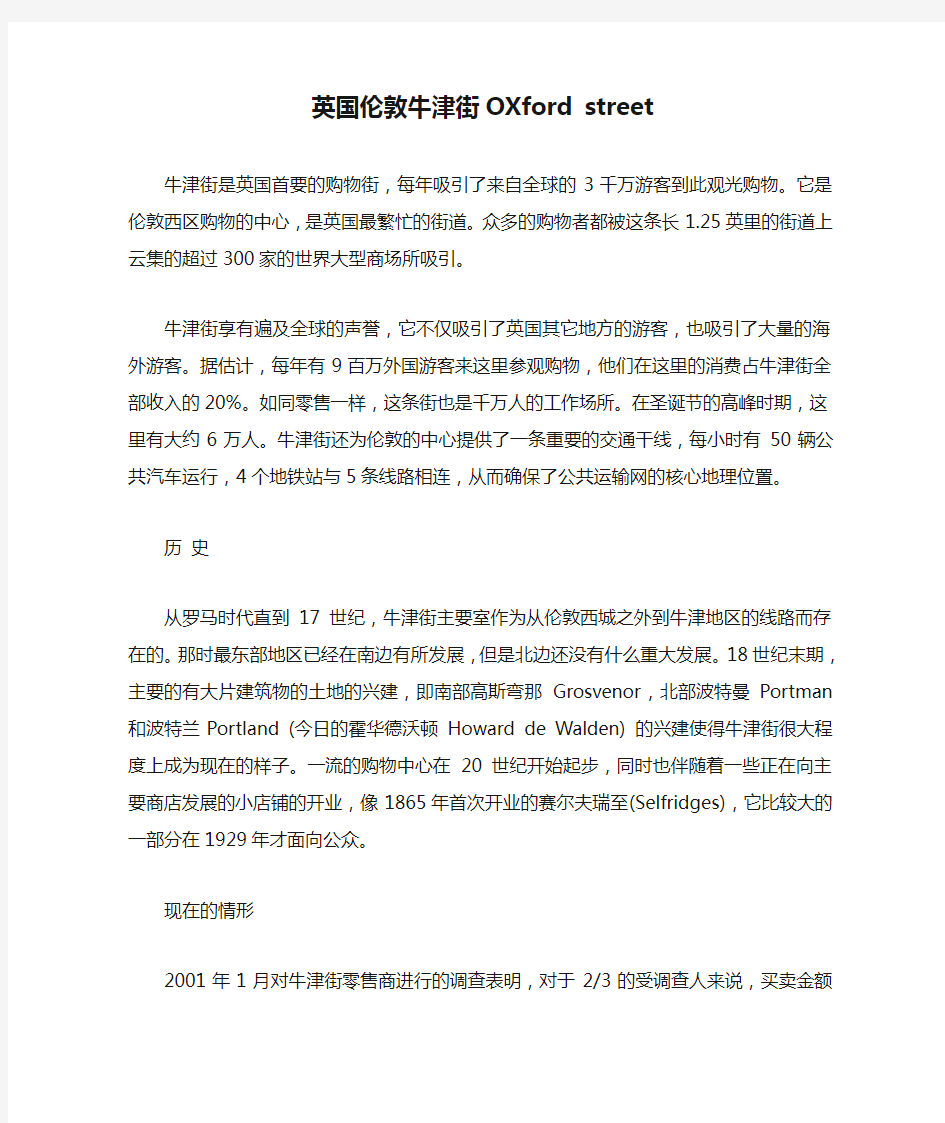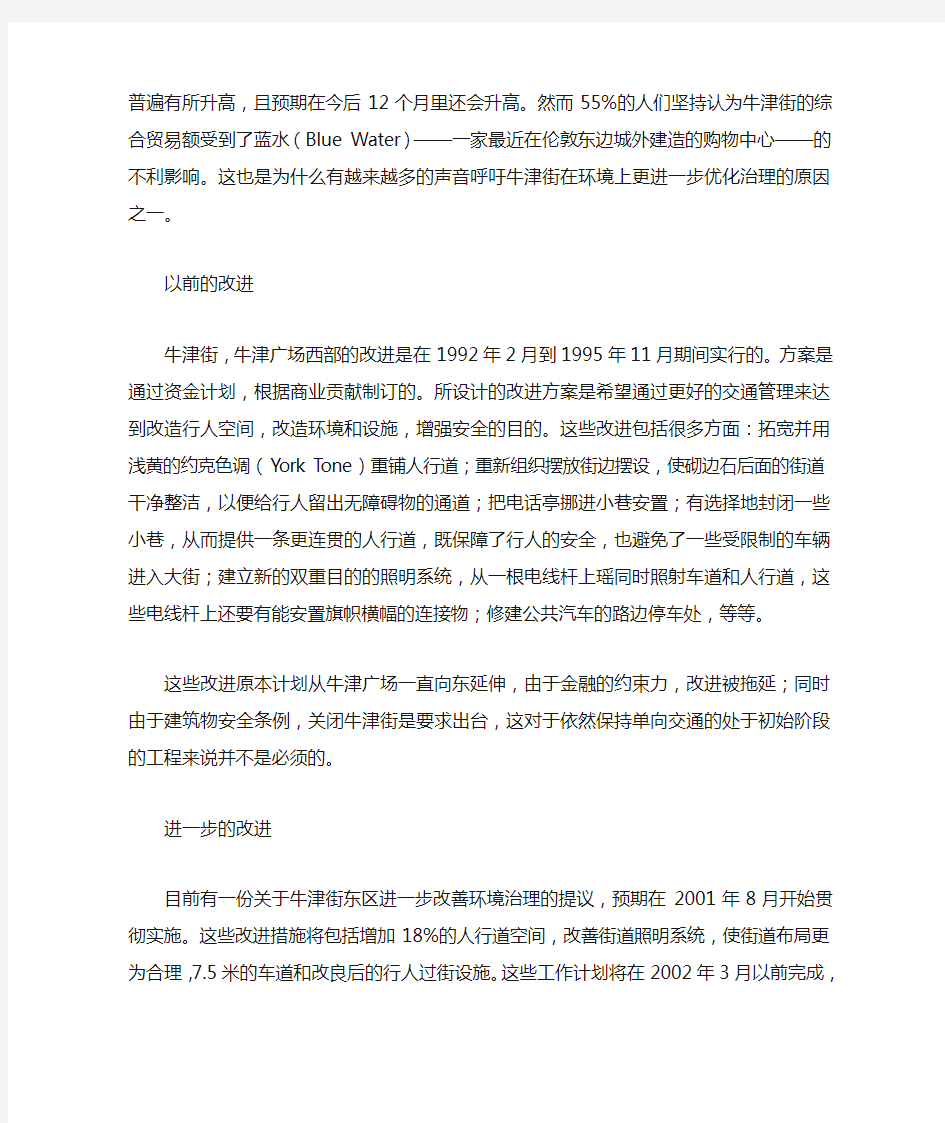英国伦敦牛津街OXford street


英国伦敦牛津街OXford street
牛津街是英国首要的购物街,每年吸引了来自全球的3千万游客到此观光购物。它是伦敦西区购物的中心,是英国最繁忙的街道。众多的购物者都被这条长1.25英里的街道上云集的超过300家的世界大型商场所吸引。
牛津街享有遍及全球的声誉,它不仅吸引了英国其它地方的游客,也吸引了大量的海外游客。据估计,每年有9百万外国游客来这里参观购物,他们在这里的消费占牛津街全部收入的20%。如同零售一样,这条街也是千万人的工作场所。在圣诞节的高峰时期,这里有大约6万人。牛津街还为伦敦的中心提供了一条重要的交通干线,每小时有50辆公共汽车运行,4个地铁站与5条线路相连,从而确保了公共运输网的核心地理位置。
历史
从罗马时代直到17世纪,牛津街主要室作为从伦敦西城之外到牛津地区的线路而存在的。那时最东部地区已经在南边有所发展,但是北边还没有什么重大发展。18世纪末期,主要的有大片建筑物的土地的兴建,即南部高斯弯那Grosvenor,北部波特曼Portman和波特兰Portland (今日的霍华德沃顿Howard de Walden) 的兴建使得牛津街很大程度上成为现在的样子。一流的购物中心在20世纪开始起步,同时也伴随着一些正在向主要商店发展的小店铺的开业,像1865年首次开业的赛尔夫瑞至(Selfridges),它比较大的一部分在1929年才面向公众。
现在的情形
2001年1月对牛津街零售商进行的调查表明,对于2/3的受调查人来说,买卖金额普遍有所升高,且预期在今后12个月里还会升高。然而55%的人们坚持认为牛津街的综合贸易额受到了蓝水(Blue Water)——一家最近在伦敦东边城外建造的购物中心——的不利影响。这也是为什么有越来越多的声音呼吁牛津街在环境上更进一步优化治理的原因之一。
以前的改进
牛津街,牛津广场西部的改进是在1992年2月到1995年11月期间实行的。方案是通过资金计划,根据商业贡献制订的。所设计的改进方案是希望通过更好的交通管理来达到改造行人空间,改造环境和设施,增强安全的目的。这些改进包括很多方面:拓宽并用浅黄的约克色调(York Tone)重铺人行道;重新组织摆放街边摆设,使砌边石后面的街道干净整洁,以便给行人留出无障碍物的通道;把电话亭挪进小巷安置;有选择地封闭一些小巷,从而提供一条更连贯的人行道,既保障了行人的安全,也避免了一些受限制的车辆进入大街;建立新的双重目的的照明系统,从一根电线杆上瑶同时照射车道和人行道,这些电线杆上还要有能安置旗帜横幅的连接物;修建公共汽车的路边停车处,等等。
这些改进原本计划从牛津广场一直向东延伸,由于金融的约束力,改进被拖延;同时由于建筑物安全条例,关闭牛津街是要求出台,这对于依然保持单向交通的处于初始阶段的工程来说并不是必须的。
进一步的改进
目前有一份关于牛津街东区进一步改善环境治理的提议,预期在2001年8月开始贯彻实施。这些改进措施将包括增加18%的人行道空间,改善街道照明系统,使街道布局更为合理,7.5米的车道和改良后的行人过街设施。这些工作计划将在2002年3月以前完成,预计耗资
3.25百万英磅。
这些工作将在与牛津街协会的磋商下实行,这一协会为其提供财政支持。协会成员是由大街的主要地产主组成的。由牛津街的前期居住者组成的新西区公司也会进行财政帮助。Oxford street
Oxford Street is the UK’S premier shopping street attracting some 30 million visitors from around the world every year. It represents the heart of London’s West End shopping making it Britain’s busiest street with shoppers attracted by one of the highest concentrations of large shops in the world with more than 300 in total along its one and a quarter mile length.
It has a world-wide reputation and attracts many visitors from both the rest of Britain and overseas. An estimated nine million foreign tourists visit the street each year and account for about 20% of its income. As well as retail the street is the
workplace for thousands of people, about sixty thousand during the peak Christmas period. The Street also provides a vital transport artery in the heart of London carrying 250 buses an hour and four Underground stations supporting five lines which ensures its geographic position at the center of the capitals public transport network..
History
From Roman times until the end of the seventeenth century Oxford Street existed primarily as a route out of the city of London westward to Oxford. The extreme eastern end had development on the south side but there was no significant development on the northern side. By the end of the eighteenth century however the growth of major estates, Grosvenor to the south and Portman and Portland (now Howard de Walden) to the north had largely fixed the line of Oxford Street that exists today. The prime shopping center really began to develop in the twentieth century with the opening of the major stores, often developing from smaller shops, for example Selfridges which first opened in 1865 but the larger part of the store didn’t open until 1909.
Current Situation
A recent Oxford Street Retailers Survey, undertaken in January 2001 has shown that the trading performance has been generally up with two thirds of the respondents expecting it to increase over the next twelve months. However 55% maintain that Oxford Street general trade has been adversely affected by Blue. Water-the recent out of town shopping center built to the ease of London. This is one of the reasons for the increasing calls for further environmental enhancements to Oxford Street.
Previous Improvements
Improvements to Oxford Street, west of Oxford Circus, were carried out between February 1992 and November 1995. The scheme was funded through the Capital Programme, with contributions from businesses. The improvements were designed to improve pedestrian space, the environment and facilities and to improve safety through the better control of traffic. These improvements included, widening and re-paving the footways with York Tone buff coloured paving. Replacing and reorganising the street furniture into one neat line behind the kerb to leave an unobstructed walkway for pedestrians. Relocating telephone booths to the sidestreets. Closing off selected sidestreets to provide a more continuous footway enhancing
pedestrian safety and preventing restricted traffic from entering the street. Erecting new, dual purpose lighting covering both the carriageway and footway from one post. The posts also included attachments enabling banners to be put up. Creating bus lay-bys….
These improvements were originally intended to be carried further east along Oxford
Street(Oxford Street east) from Oxford Circus. The improvements were stalled due to financial constraints and the requirement to close the street due to changes in construction safety regulations, which was not necessary for the previous phases of the work where one way traffic was maintained.
Further Improvements
Currently there is a proposal for further environmental improvements for the eastern section of Oxford Street with implementation expected to start in August 2001. These improvements would include upgrading and increasing the footway space by 18%, improving street lighting, rationalizing street furniture, a 7.5m carriageway and improved pedestrian crossing facilities. This work is scheduled for completion by March 2002 and estimated to cost 3.52m.
This work will be carried out in consultation with the Oxford Street Association who is contributing financially to it. The association is made up of the major landowners on the street. There is also the New West End Company, which is made up of the occupiers of the premises on Oxford Street.
感谢您的阅读!
